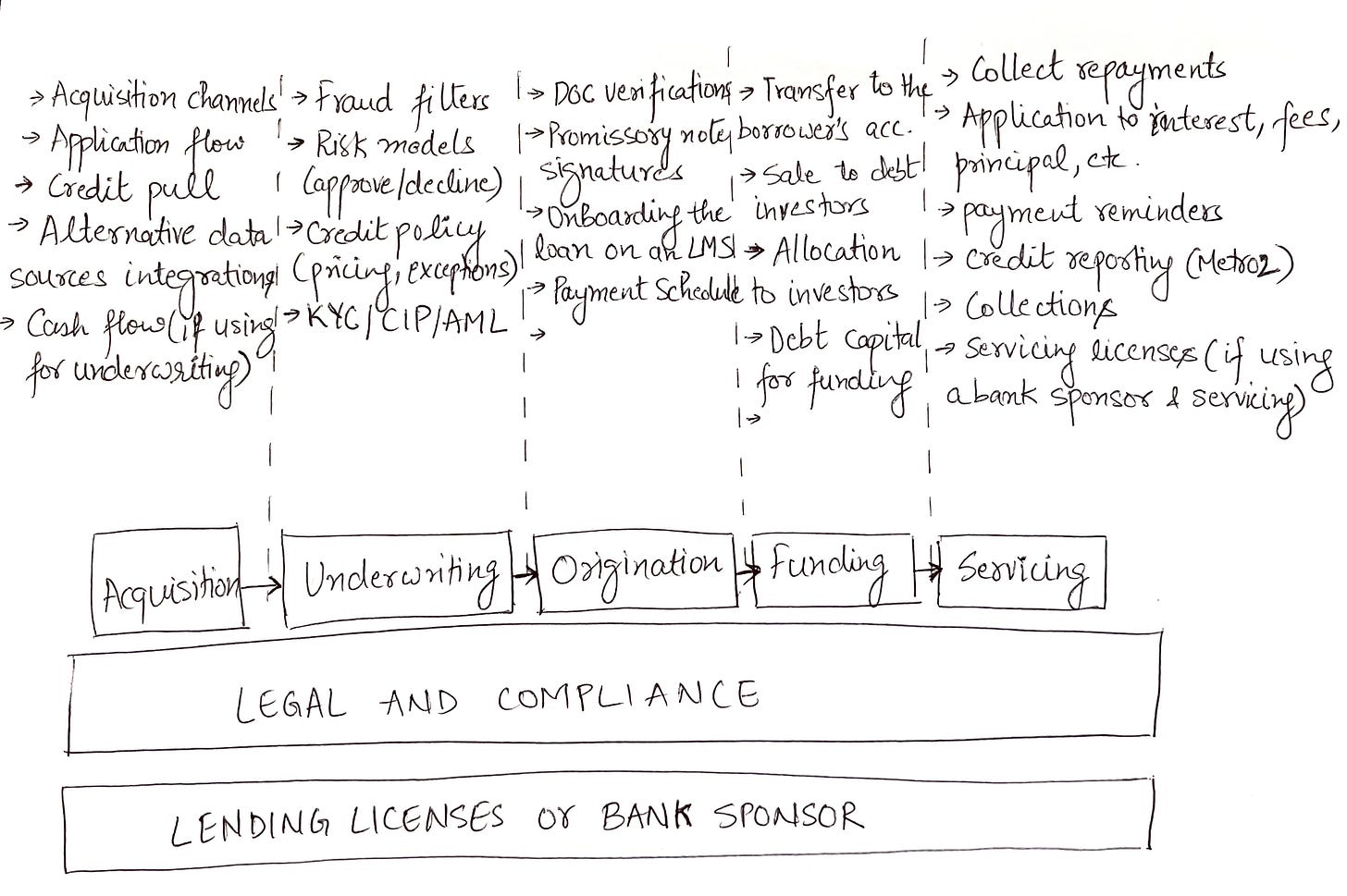A brief guide to building your first lending product
For building financial products, you need to be clear on a lot of details before you start. I'll share how to think of lending a product flow and the key factors for each of them.
Credit products, unlike many others, can’t be launched without figuring out many details at the outset. Even though the fintech landscape is exploding, it remains difficult for founders to launch quickly.
Depending on your product - credit card, personal loan, mortgage, auto loan, etc. - your compliance regulations, risk models, operations, processes, and funding models are going to be different and super complex. There are unique nuances to each of these products and you’d need to learn those prior to launch.
Some products require expensive and tricky partnerships. e.g. if you are building a card product, you’ll need to work with Mastercard or Visa networks and you’ll need a bank sponsor (lending licenses may not work). Designing a card requires multiple levels of approvals.
Now, there are many fintech infrastructure products to help build your next credit product. BaaS platforms have been around for a few years. But, as a new founder, it’s still difficult to integrate these products. There is a steep learning curve because of the product complexity and there’s no standard integration setup.
No single product or vendor really solves the whole problem, so multiple complex products need to be integrated. To build your products effectively, you also have to navigate a minefield of regulatory and capital requirements.
You can evaluate and pick the right stack if you pre-think through all the details of your product. Working through the product details is easier if you break down your lending product into steps (or functions). A few key questions for each of these steps will help you crystallize what’s important. Another reason it’s helpful is because most of the tools are designed around solving the challenges of each specific step.
Below is a sample of an unsecured consumer personal lending company flow. The loan product flow has 5 main steps:
Acquisition
Underwriting
Origination
Funding
Servicing
There are no standard steps defined in the industry. But I broadly think of them as clear demarcation points. This is also how companies tend to organize their internal functions.
Let’s explore these steps a bit more:
Acquisition
acquiring customers through various channels
application flow to get the information needed to make an underwriting decision
credit pull integrations (if you plan to use credit reports to underwrite)
bank account integrations (if you plan to use cash flow underwriting)
document uploads (generally done after a customer accepts a loan offer)
Underwriting
fraud screening
risk model for approval/decline decisions
policy to decide pricing like interest rate, loan amount, term, etc (you may have just one price for everyone)
Origination
document verifications per underwriting procedures
get the required documents signed (e.g. promissory note)
onboard the loan onto a loan management system
generate payment schedule
prepare the paperwork (everything is verified) so the loan can be funded
Funding
transfer funds to the borrower’s account
sell the loan to debt investors (if not using your own capital)
Servicing
deduct payments from the borrower’s account
applying payments to interest, principal, and fees
calling, emailing, and messaging payment reminders
sending monthly statements
reporting to credit bureaus (Metro2)
collecting on delinquent accounts
What you’ll need in addition to all of the above:
Licenses (or a bank sponsor)
Compliance program
Debt capital
When working with a bank sponsor, the scrutiny is significantly higher. So you’d need to know the details of your product prior to establishing these partnerships. Debt capital and compliance are their own beasts.
If you want to learn more about raising debt capital, feel free to read these posts:
Here’s how the functions look:
For each of these steps in the process, you need different APIs, tools, products, services, etc. To accomplish all these tasks you need to stitch together disparate tools that don’t talk to each other. There are no Zapier like pre-built connections.
You will need answers to a lot of these questions prior to using fintech infrastructure tools. Because the configurations will be unique for each company and product details. The clearer your product details, the faster you can pick the right tool, integrate it, and launch your credit product.
It’s not expected that you’ll know everything when you start. But it’s still important to understand the core components and the non-negotiables for each step.
Recently, fintech tools have added features to cover multiple steps of the overall flow. Alloy has expanded to underwriting tools, Peach has added a ton of compliance features and reporting, Canpoy has been building integrations with partners, etc.
As I mentioned above, depending on the type of product and customer, the details of your lending flow will look different. There’s hidden complexity, regulatory requirements, and nuances you’d need to figure out.
You can read more about these topics in the posts below:
The better you can define your requirements, the easier it will be to build the right stack for your startup.
Hope this helps.
Feel free to reach out if you have any questions.
**Fintech startups serving businesses tend to have fewer regulations and are easier to launch compared to consumer businesses.


Hi Rohit. I have been founding member of Bangladesh's biggest startup ShopUp. I've recently moved to Canada and I'm seeing a gap in the immigrant student loan market due to lack of credit scores. I see you built a very similar company in the states. What are your thoughts on the potential Canadian market? Any reason you didn’t expand to Canada?